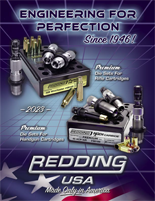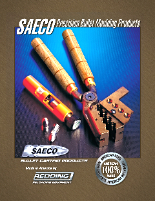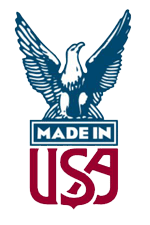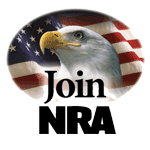Tech Line & Tips (FAQs)
Dealing with Headspace by Todd Spotti
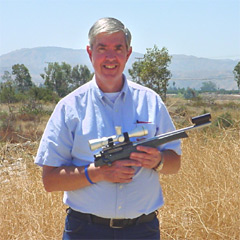 Headspace is one of those concepts that is both very simple and yet is extremely important to achieve gilt edged accuracy. For bottlenecked cartridges, headspace is simply the distance between the head of the cartridge case (the end where the primer is inserted) and the front/face of the firearm's bolt when the case's shoulder is positioned against the front of the chamber.
Headspace is one of those concepts that is both very simple and yet is extremely important to achieve gilt edged accuracy. For bottlenecked cartridges, headspace is simply the distance between the head of the cartridge case (the end where the primer is inserted) and the front/face of the firearm's bolt when the case's shoulder is positioned against the front of the chamber.
Firearms manufacturers have a problem in that the chambers in their guns have to be long enough to accommodate all of the cartridges of a given kind made by literally hundreds of manufacturers from around the world - all of which will vary slightly in length due to normal manufacturing tolerances. Consequently a certain amount of "slop" is built into the length of chamber to accommodate those differences. However, that slop can reduce accuracy.
The goal of every conciencious reloader should be to use proven and practical reloading procedures in order to ensure that the bullet/case combination is as perfectly aligned with the center of the bore as possible. The more centered up the cartridge, the more accuracy we can expect. However, if the cartridge is laying loose in the bottom of the chamber because of a generous headspace dimension, it's obvious that the bullet will be pointed closer to the bottom of the bore rather than the center. Consequently, accuracy conscious shooters will want to reduce headspace to the absolute minimum i.e. where the shoulder of the case is against the front of the chamber wall and the bolt/breech face of the firearm is very close to or even lightly touching the head of the case. We can do this by adjusting the shoulder of our fired cases in the sizing process. However be aware that when we do so, we're customizing those cases to a precise fit in one particular gun. This means that those cases will probably fit only in that gun and in no other.
Headspace is like Goldilocks porridge. It has to be just right for the best accuracy. Too much is bad and too little is also bad. So how do we know when we have too much headspace? There are a couple of obvious tell tale signs on our fired cases that are sure fire indicators. The first is a protruding primer. If, after firing, you see the primer is backed out of the primer pocket, even a little bit, you have excessive headspace. Remember, the top of the primer in an unfired case is supposed to be located just below the case head after it has been seated. If it's sticking out after the shot has been fired, the case is too loose in the chamber.
The second indication of too much headspace is a excessively stretched case. When the powder is ignited, the case is expanding in all directions, including front and rear. Brass does have a limited amount of "springback", but when the amount of headspace exceeds the ability of the case to springback, the case will be permanently stretched and weakened. Stretched cases can be easily identified by a bright, light colored ring located just forward of the head. The case at that point has been stretched dangerously thin. Those cases should be thrown away immediately as they will come apart at that point sooner or later. Case head separations can sometimes be very nasty.
The ideal amount of headspace for the best accuracy is zero. In other words, all space behind the case head has been eliminated. When the bolt face is just touching the case head or is just, behind the case head, two good things are happening. One - the cartridge is aligned as well in the chamber as is possible. Two - when the firing pin hits the primer, the case will not be able to slide forward under the impact and will stay firmly in place. Consequently, the full force of the firing pin's blow will be delivered against the primer cup insuring efficient ignition. However, there is such a thing as going too far in our efforts to eliminate excess headspace.
One problem that many shooters using hard recoiling cartridges experience occurs when the headspace is less than zero. In other words, a hot load is stretching the case lengthwise to the point that if the case is just neck sized, it'll be a difficult fit in the chamber. In such cases, the shoulder has been moved so far forward that the bolt handle either won't go down or it will go down only with some degree of difficulty. These cases can also be identified by scrape marks on the head as a result of the bolt face rubbing that area under pressure as its being turned. You might also see brass scrapings on the bolt face itself. The cartridge is actually being inserted into the chamber with a crush fit. Under those circumstances, case life will be significantly reduced - especially primer pockets.
One way we can achieve an ideal headspace with these cases with shoulders that are too far forward is by adjusting our resizing die so that the case's shoulder is moved back to the ideal headspace location. To do so, raise the ram of your reloading press to the top position with the shellholder installed. Take your full length sizing die and screw it down to the point where it's touching the shellholder. Now back off the die by about a half turn. Run a lightly lubricated fired case into the die, and then try chambering it in your gun. If the case does not chamber, or chambers only with difficulty, screw the die down just a bit more (1/8th turn) and size the case again and rechamber. Keep repeating this procedure until the bolt on your gun just closes freely or as I prefer, with a very slight bit of resistance. Now lock the die in place. This is the classic method for adjusting headspace.
A good alternative is to use Redding's Competition Shellholder Kit. The kit is composed of five thicker* than normal shellholders which are packaged together in a neat little plastic case. A normal shellholder is .125" thick. The five competition shellholders are thicker* in increments of two thousandths of an inch i.e. +.002", +004", +.006", +.008", and +.010". Each shellholder is stamped with its increase in depth, and they are Black Oxide coated so they can't be confused with a regular .125" shellholder.
Using them is very easy. Start with the +.010" shellholder. Install on the press's ram and raise to the top position. Screw down the sizing die to the point that it's making firm contact with the shellholder. When that happens, the die is now being "squared" or aligned with the shellholder.
Lock the die in place. OK, take a fired, lubed case and run it into the die and then try chambering it into your gun. If it doesn't chamber, go to the +.008" shellholder and repeat the "squaring", resizing, and chambering procedure. Keep repeating until the case chambers easily. Cases sized with that shellholder now have the optimum headspace for the best case alignment.
One last note. If you size more than one type of case with these shellholders, keep a record of what shellholder to use for which cases. Also if you switch case brands, or even case lots, double check to see if the shellholder and die setting is still good. Differences in brass thickness and brass hardness can make a difference. This also applies sometimes even if you switch brands of lubricant. Strange but true.
Once you have your case's headspace squared away, you can be assurred that the chamber fit of your reloaded ammo will be "just right". Goldilocks would be proud.
*( Editor"s Note: the shellholders are actually the same thickness but the seat on which the case rests is machined deeper into the body of the shellholder giving the mechanical effect of a shellholder which would be thicker from the casehead to the top of the shellholder where it contacts the base of the die. By using this method, there is no need to readjust the die between the 5 different shellholders to accomplish the desired shoulder set back.)


